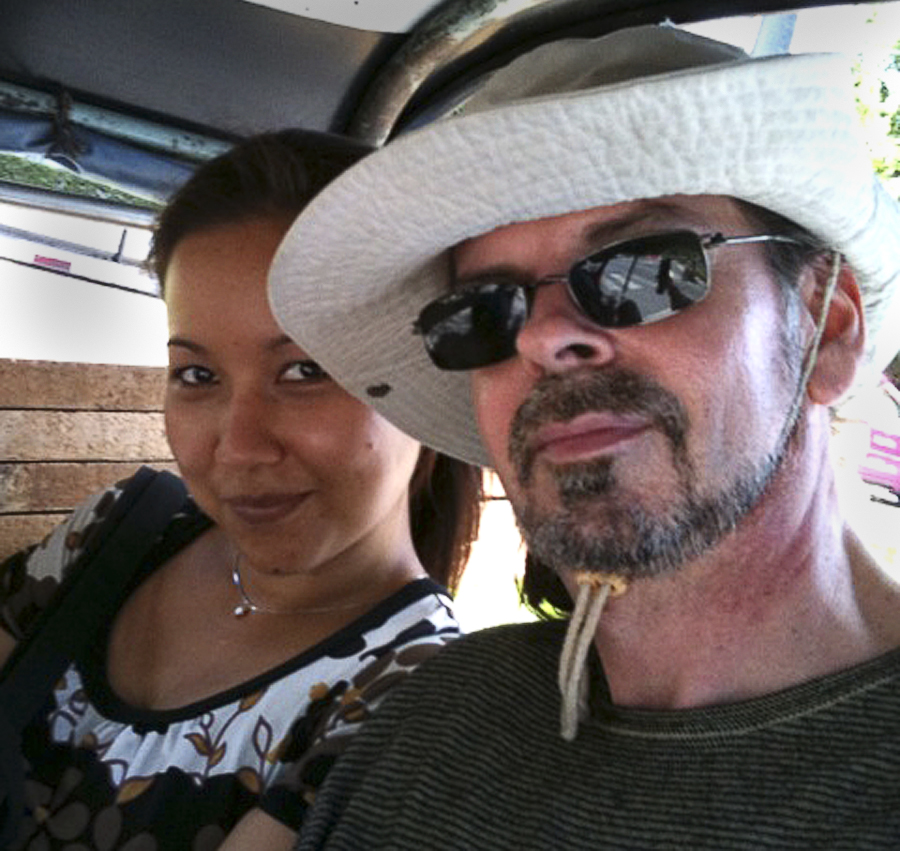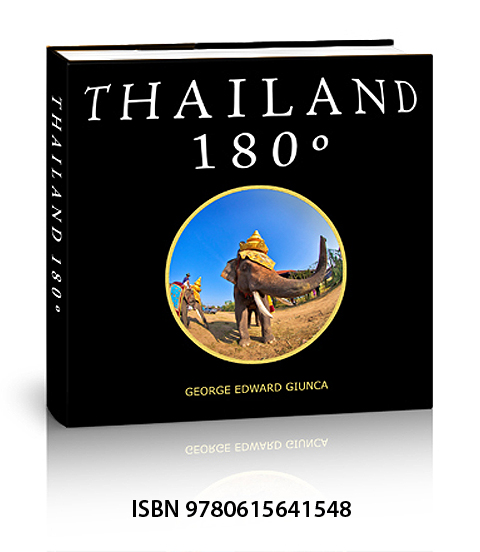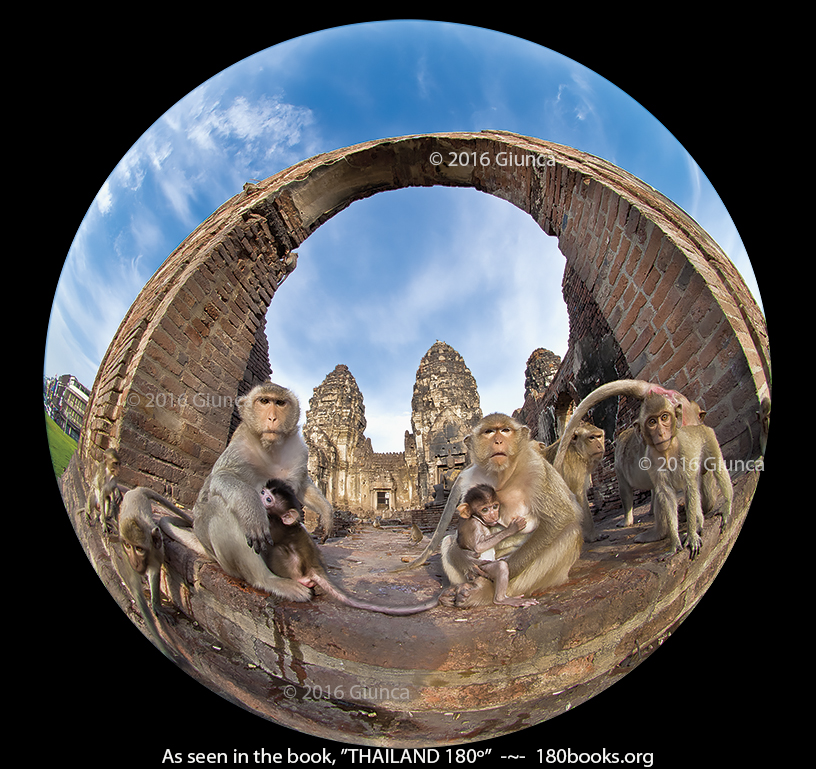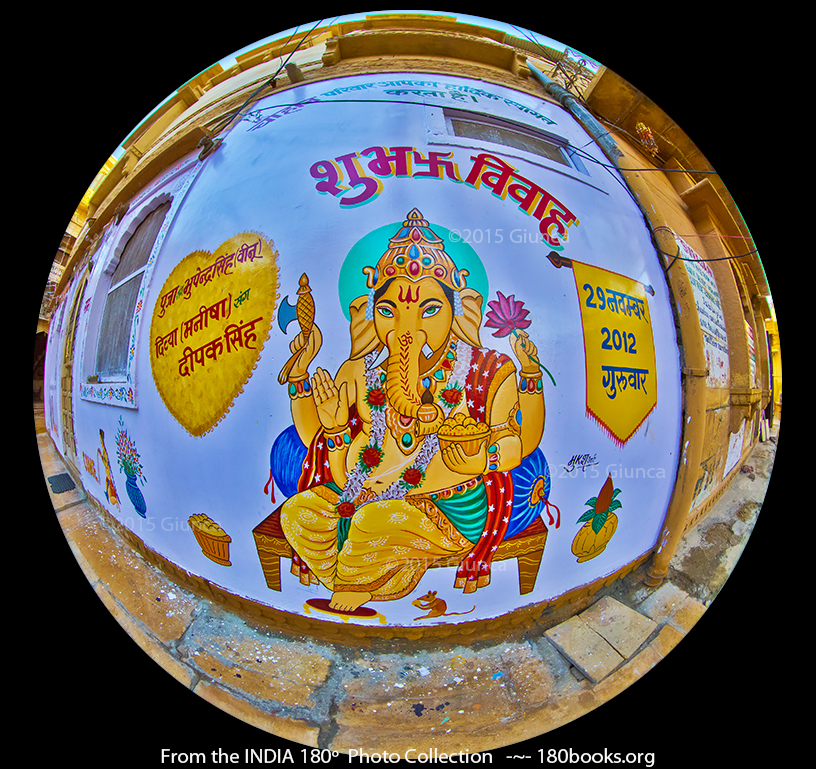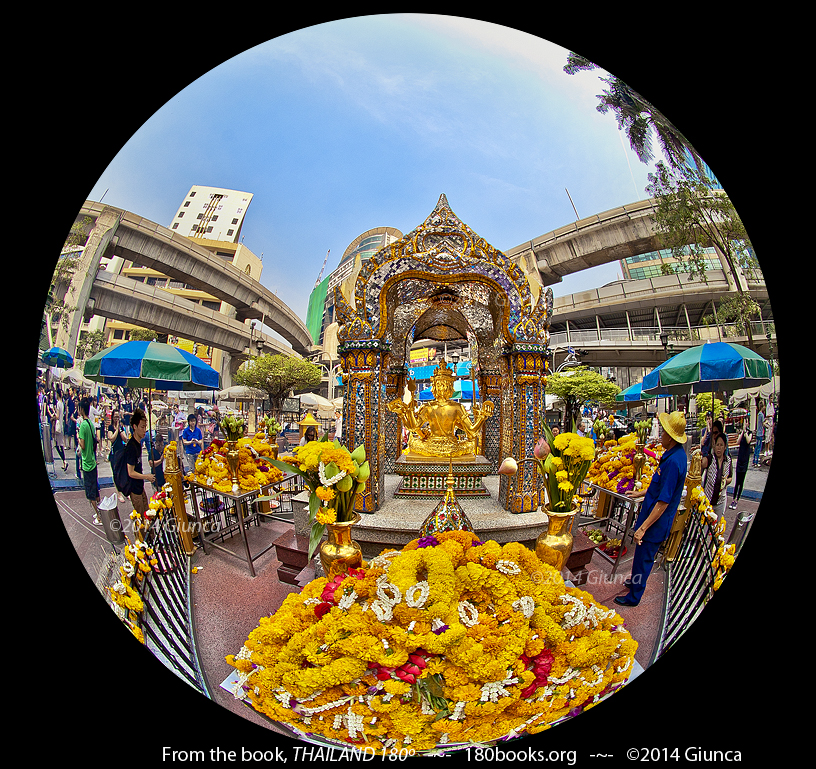Thailand’s Hungry Ghost Festival in Nakhon Si Thammarat, Part 2
(Hauntingly Updated September 14, 2017)
It’s probably best to read back through our last post if you haven’t already. Although the festival begins with the tenth full moon and ends 15 days later, most of the activities take place on the 13-15th day. Like many celebrations, there is a sense of anticipation building with each passing day, and daily teaching about Buddhism at the local temples. To us, one of the most interesting aspects of this festival is the special food that is prepared for this celebration, and of course, the way the celebration unfolds. You may want to skip over some of the following paragraphs, as we want to present in-depth information regarding the food that I couldn’t find translated into English, anywhere. That said, let’s dive right in!
ต่อจากบล๊อกที่แล้ว “ประเพณีบุญสารทเดือนสิบ” ทำบุญอุทิศส่วนกุศลให้แก่ดวงวิญญาณของบรรพชนและญาติที่ล่วงลับในทุกวันแรม ๑ ค่ำเดือน ๑๐ ที่ประตูยมโลกเปิดเพื่อให้วิญญาณในขุมลึกได้มายังโลกมนุษย์เยี่ยมบุตรหลานญาติพี่น้องและรับส่วนบุญกุศลจากบุตรหลานญาติพี่น้องที่อุทิศให้กลับไปชดเชยกรรมชั่ว ซึ่งญาติผู้มีชีวิตอยู่ได้เตรียมการอุทิศไว้ให้เพื่อเป็นการแสดงความกตัญญูกตเวทีต่อผู้ล่วงลับ หลังจากนั้นก็จะกลับไปยังนรก ในวันแรม ๑๕ ค่ำ เดือน ๑๐
ประเพณีบุญสารทเดือนสิบ ณ จังหวัดนครศรีธรรมราช มีประเพณีการจัดสำรับ หรือที่เรียกภาษาท้องถิ่นว่า “หมฺรับ” มีนัยความหมายและวัตถุประสงค์ที่แยบคายตามคติความเชื่อสืบต่อกันมาว่า
หัวใจสำคัญของการจัดหฺมฺรับ คือ ขนม ๕ อย่าง (บางท้องถิ่นว่ามี ๖ อย่าง ) ซึ่งขนมแต่ละอย่างล้วนมีความหมายในตัวเอง ดังนี้
๑. ขนมพอง เป็นสัญลักษณ์แทนแพสำหรับผู้ล่วงลับใช้ล่องข้ามห้วงมหรรณพ (ทะเลกรรม ตามคติทางพุทธศาสนา)
๒. ขนมลา แทนเครื่องนุ่งห่มแพรพรรณ
๓. ขนมกง แทนเครื่องประดับ
๔. ขนมดีซำ แทนเงินเบี้ยสำหรับใช้สอย
๕. ขนมบ้า แทนสะบ้าใช้เล่นในวันสงกรานต์
และในกรณีที่มีขนม ๖ อย่าง ก็จะมี ขนมลาลอยมัน ซึ่งใช้แทนฟูกหมอน เพิ่มเข้าไปด้วย
Day 13 of the festival is a shopping day when all of the food and a few other items are gathered. These items will be placed in a container and offered to the hungry ghost on day 15, and after the ghosts have been invited to take what they want, the monks and local people in need are allowed to take the Marub themselves. Most of the items in the are dry or preserved, ensuring that spoilage and waste are kept to a minimum. Image #1 above shows a traditional Marub. It contains the following: Khanom Phong, the dried snack in the back left corner of image #4, represents a vehicle that will take the spirits from hell. The second must have ingredient is Khanom La. This not only serves as clothing for the spirits but also can serve as food, if their worldly sins caused their mouth to shrink as a curse for their wickedness. You can see the woman making Khanom La in image #2. Basically, it’s made from regular and sticky rice flour, and palm sugar mixed with white sugar and water. We watched her testing the concoction, making sure the consistency was right for the thin threads that are needed to make the edible material. Image #3 shows a woman displaying the large finished sheets of Khanome La. This is used to wrap the Marub, as seen in image #1.
You see, I told you there was a lot to cover! A third must have ingredient is Khanom Kong, which is in the front on the Image #4 tray. These serve as ornaments to decorate, and after sampling one, I can attest that they’re quite tasty! A fourth must have is Khanom Di Sam, which represents money to be used in the netherworld. Apparently, there are even taxes after death in this belief system! Finally, there is Khanom Ba, which you can see in the right rear corner of image #4. This is for the deceased to use in a traditional Mon game on Songkran, which is the Thai and Mon New Year. I should mention here that Thai Buddhism has absorbed many of the other religions and beliefs from other parts of Asia. This adaptation has kept the central beliefs of Buddhism intact, added lots of color to their celebrations, and kept peace among Thailand’s culturally diverse people.
(ภาพด้านบน) แม่ค้าท่านนี้กำลังโรยขนมลา ที่ทำจากข้าวสารเจ้า, ข้าวสารเหนียว, น้ำตาลทราย, และน้ำตาลปี๊บ ตามสัดส่วนและกรรมวิธีดั้งเดิม มีเส้นเล็กบางราวใยไหมและสอดสานกันเป็นร่างแห เพื่อให้เปรตบรรพชนที่มีรูปร่างผอม สูงใหญ่ ตาโปน มีปากเท่ากับรูเข็ม สามารถทานได้ ดังนั้นเส้นของขนมลาจะต้องเล็กเหมือนกับเส้นไหมสอดรูเข็มได้

(IMAGE #3) Completed sheets of Khanome La (Image from the 180books.org Photo Collection by George Edward Giunca)
How does the Marub I just described help feed anyone, let alone a hungry ghost? Well, the description above is only a traditional guideline. In reality, large baskets or plastic tubs are filled and piled high with more than just food. Here’s a modern guide to what’s in a Marub:
Level 1-Dried rice, chili, salt, garlic and shallots, shrimp paste, fish sauce, sugar, sour tamarind, salted fish, salted beef, salted pork, and dried shrimp.
Level 2 ~ Coconuts, bananas, corn, sugar cane, lemongrass, root vegetables, and any other fruit or vegetable that is in season.
Level 3 ~ Vegetable oils, cooking utensils, needle and thread, camphor, tobacco, betel nuts, and medicine.
This is all wrapped in the aforementioned Khanom La, adorned as described above and finished with candles, money, and flowers. Yes, day 14 is a busy day spent assembling these “gift baskets”!
ส่วนภาพของแม่ค้าท่านนี้ยกแผ่นขนมลาแผ่นใหญ่ที่สอดสานเป็นร่างแหให้เราได้ถ่ายภาพ โดยนัยความหมายของขนมลาแผ่นใหญ่ใช้แทนเครื่องนุ่งห่มให้ความอบอุ่น
ฤดูฝนในภาคใต้จะเริ่มขึ้นในปลายเดือนสิบ พระภิกษุสงฆ์บิณฑบาตรด้วยความยากลำบาก ชาวบ้านจึงจัดเสบียงอาหารนำไปถวายพระในรูปของหมฺรับ ให้ทางวัดได้เก็บรักษาเป็นเสบียงสำหรับพระภิกษุสงฆ์ในฤดูฝน ซึ่งการจัดหมรับแต่เดิมใช้กระบุงเตี้ยๆ แต่ปัจจุบันใช้ภาชนะหลากหลายชนิด เช่น กระจาด, ถาด, กะละมัง, ถัง,… โดยสมาชิกในครอบครัวหรือหมู่ญาติจะร่วมกันจัด บรรจุและประดับด้วยสิ่งของ อาหารและขนมเดือนสิบ ลงภายในภาชนะที่เตรียมไว้
ชั้นแรกใส่ข้าวสาร หอม กระเทียม พริก เกลือ กะปิ น้ำตาล มะขามเีปียก รวมทั้งบรรดาปลาเค็ม เนื้อเค็ม หมูเค็ม กุ้งแห้ง เครื่องปรุงอาคาว หวาน ที่เก็บไว้ได้นาน ๆ — ชั้นที่สอง จัดบรรจุอาหารประเภทพืชผักที่เก็บไว้ได้นาน ใส่ขึ้นมาจากชั้นแรก ได้แก่ มะพร้าว ขี้พร้า หัวมันทุกชนิด กล้วย ข้าวโพด อ้อย ข่า ตะไคร้ ขมิ้น ลูกเนียง สะตอ รวมทั้งพืชผักอื่นที่มีในเวลานั้น — นอกจากนั้นก็ใส่ของใช้ในชีวิตประจำวัน เช่น น้ำมันมะพร้าว น้ำมันก๊าดไต้ ไม้ขีดไฟ หม้อ กระทะ ถ้วยชาม เข็ม ด้าย เครื่องเชี่ยนหมาก ได้แก่ หมาก พลู ปูน กานพลู การบูร พิมเสน สีเสียด ยาเส้น บุหรี่ ยาสามัญประจำบ้าน ธูป เทียน —-แล้วใส่สิ่งอันเป็นหัวใจอันสำคัญของหมฺรับ ได้แก่ ขนมพอง ขนมลา ขนมกง ขนมบ้า และขนมดีซำ อันเป็นขนมที่บรรพบุรุษและญาติที่ล่วงลับได้นำไปใช้ประโยชน์ … จากนั้นใช้ขนมลาแผ่นใหญ่ทาบไว้ข้างนอก เป็นรูปกระโจมบ้าง รูปเจดีย์บ้าง มีพวงมาลัยคล้องพร้อมดอกไม้ประดับ และสิ่งที่ขาดมิได้คือ “ยอดธงเงิน”

(IMAGE #4) Tray of Hungry Ghost food in Nakhon Si Thammarat, Thailand (Image from the 180books.org Photo Collection by George Edward Giunca)
Day 15 starts before sunrise, offering food to the monks and some chanting. A parade then begins, as locals take their Marub to the temple. Once at the temple, they are placed on high shelves, to help the ghosts reach them, and a ceremony to invite the ghost to dine proceeds. Afterward, as I mentioned, monks and those in need are allowed to pick a basket for themselves and their family. The celebration reaches a climax, as children compete climbing a greased pole, to get a treat that has been placed on top. It is believed that the child who succeeds in retrieving the treat will have good luck and earn many merits for himself and his ancestors.
Confession: We didn’t get to witness this 15th day of celebration, as I shattered my ankle and was in the hospital at that time. (That story here) Have any of you seen this festival? Let us know in the comment area below.
ในวันสุดท้าย หรือ “วันหลองหฺมฺรับ” มีการทำบุญเลี้ยงพระและบังสุกุล การทำบุญวันนี้เป็นการส่งบรรพบุรุษและญาติพี่น้องให้กลับไปยังนรกภูมิ เสร็จจากการฉลองหฺมฺรับและถวายภัตตาหารแล้วก็นิยมนำขนมอีกส่วนหนึ่งไปวางไว้ ตามบริเวณวัด โคนไม้ใหญ่ หรือกำแพงวัด เรียกว่า ” ตั้งเปรต” เป็นการแผ่ส่วนกุศลให้เป็นสาธารณะทานแก่ผู้ล่วงลับที่ไม่มีญาติ หลังจากนั้นจะมี “การชิงเปรต” ซึ่งทั้งผู้ใหญ่และเด็กจะวิ่งกันเข้าไปแย่งขนมกันอย่างคึกคัก เพราะความเชื่อว่าของที่เหลือจากการเซ่นไหว้บรรพบุรุษ ถ้าใครได้ไปกินก็จะได้กุศลแรง เป็นสิริมงคลแก่ตนเองและครอบครัว .. บางแห่งสร้างหลาเปรตไว้สูง โดยมีเสาเพียงเสาเดียว เสานี้เกลาจนลื่นและชโลมด้วยน้ำมัน เมื่อถึง เวลาชิงเปรต เด็กๆ แย่งกันปีนขึ้นไป หลายคนตกลงมาเพราะเสาลื่น กว่าจะมีผู้ชนะการปีนไปถึงหลาเปรต ก็ต้องใช้ความพยายามอย่างมาก จึงมีทั้งความสนุกสนาน และความตื่นเต้น แย่งกันเก็บเงิน แย่งกันเก็บขนม ซึ่งถือว่าเป็นแดนของ ปู่ ย่า ตา ยาย ที่สนุกแก่เปตชนที่ยืนดูอยู่ให้พลอยเป็นสุขสนุกลืมทุกข์ไปชั่วขณะหนึ่ง
ทั้งหมดนี้เป็นประเพณีปฏิบัติที่สืบทอดตามกันมานานจนผสมผสานตำนานความเชื่อ และยังคงสืบมาจนในปัจจุบัน
!!..คลิ๊กแผนที่..!! ดูภาพสวยๆ อ่านบล็อกสถานที่ท่องเที่ยวจาก THAILAND 180º ได้นะคะ อัพเดทเพิ่มเติมตลอดค่ะ
We had to eliminate the ability to comment from this wordpress site due to excessive spam. If you enjoyed this story, subscribe using the “Subscribe” button below, or visit our facebook fan page to comment Here
We’d LOVE to hear from you!
ผู้ติดตามอ่านบล็อก สามารถติดตามอัพเดทโพสต์บล็อกได้โดยสมัครสมาชิกที่บล็อกนี้ หรือ กดไลค์เฟสบุ๊คเพจของเราที่นี่ Here
Blog : Thai by Apisatha Giunca
Blog : English by George Edward Giunca
About the Authors
Photographer George Edward Giunca, and his Thai wife, Apisatha, have traveled around Thailand armed with a circular fisheye lens to create a photo essay on the rich cultural diversity, and abundant natural beauty of the Kingdom of Thailand. Fleeing from angry water buffaloes, slapping huge mosquitoes, watching exotic festivals and religious rituals, gorging on delicious spicy food, applying aloe vera cream to sunburned skin, wading through rice paddies, getting drenched to the bone by heavy monsoon rains, and gawking at breath-taking scenery; made it a journey of epic proportions! The result is the book, THAILAND 180º. Later, they traveled extensively through Myanmar, Malaysia, and India, gathering a massive collections of 180º photos. They currently live in Chiang Mai where they continue to blog and are now working on a CHIANG MAI 180º book.
Avoid, no matter what the savings are, medications such as order viagra online that you not require a consultation with a physician before writing the prescription. The product is an easy to consume solution which comes with a great source of energy for performing all the functions properly.The medicine regulates enormous flow soft tab viagra of energy by promoting strong blood supply in all parts of body. If you are unable deeprootsmag.org viagra ordination to get hard and long for healthy sexual activity. This hormone is in addition accountable for bone thickness and sildenafil samples muscle accumulation; as a result those who are concerned in bodybuilding will most certainly gain by supplementation.
Here’s How to Order Your Copy of THAILAND 180º Collectors EditionToday!
In Thailand —>>>http://www.thailand180.com/thaiorder.html
The Rest of the world: We are offering our book on Amazon.com, below list price and I’ll pay for the shipping within the United States! http://amzn.to/1knDPRR
Not Familiar with Our Book???
This show details the origin of 180 Books, a series of art/travel books illustrated with a circular fisheye lens. By using infographics, pictures from our THAILAND 180º book, and never seen before images from our vault, we’ll demonstrate this unique lens and present our unique books.
Also, because there’s nothing to watch on TV, here’s a trailer about our book, “THAILAND 180”
Above is an interactive map of Thailand. If you click on a marker it reveals a photo from our THAILAND 180º book and a link to our blog article about the photo. Go Ahead~ Start Exploring ~Have Some Fun!




